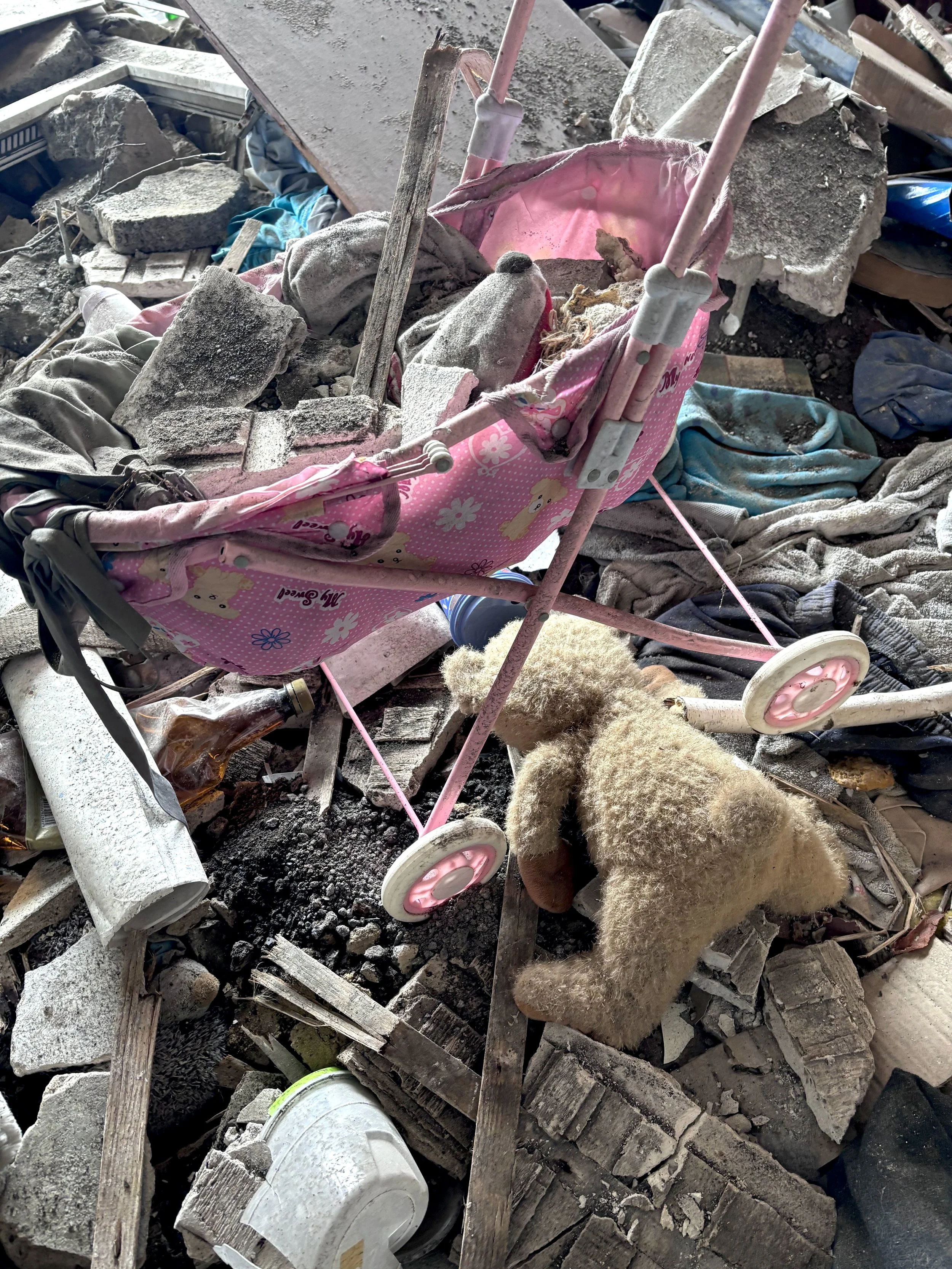izyum, part i: russian war crimes at 2 Pershotravneva street
March 20, 2025
Today I returned to Izyum, a town occupied by russian forces for 6 months from March to September 2022. On March 9, 2022, in violation of Protocol I, Article 51 of the Geneva Convention, russian forces used large aviation bombs on several residential apartment buildings in Izyum. In the bombed building located at 2 Pershotravneva Street, over 50 civilians were killed. Generations died in the attack, including entire families, ages ranging from 3 to 97. I first visited this building in 2024, two years after the impact. What I saw here has haunted me for over 12 months and I have not been able to write about it. I returned today to face this place again and to see whether this site, and my ability to absorb its tragedy, have changed.
2 Pershotravneva Street, Izyum, Kharkiv Oblast, Ukraine. Photo courtesy Laurence Reay, March 2025.
There are hundreds of apartment buildings in Ukraine that suffered the same fate as 2 Pershotravneva Street. The russian bombers flew overhead, targeting the center of the buildings with 1000-1500 pound aviation bombs, in repetition of the same pattern. The first strike vaporizes the center column of 5 floors containing 20 apartments to clear the way for the second hit. The russian bombers then circle back a few minutes later and guide a second 1000 pound bomb directly at the building’s underground basement, rendered vulnerable by the first hit. The architecture of these apartment blocks is ubiquitous throughout the former soviet union, both in Ukraine and in russia. The buildings follow a blueprint of three columns of 20 apartments each, with a subterranean basement at the center, intended to serve as a makeshift bomb shelter in the event of an aerial attack. The russian pilots know this and bomb for maximum kill efficiency. An elderly woman, sweeping broken window glass in Milova, a nearby village whose residential buildings suffered the same fate on March 9, 2022, told me that after the bombers dropped their first payload, she then heard them return minutes later to drop the second bomb in the same place to penetrate the bomb shelter. The death of civilians hiding underground beneath the center of each building is the aim of this tactic.
A child’s room, March 2024.
On 2 Pershotravneva Street, the 50+ people who died were all civilians, many of them children. Entire families were entombed in the basement as they huddled underground for safety. Two and half years since impact and the mess of mangled toys, children’s clothing, burned ceiling tiles, tattered curtains, shredded wallpaper, dusty books, shoes, hats, baby strollers, cooking pots… are all still here. I am a grave robber, trudging through these halls, broken glass crunching under my winter boots. This macabre tomb is part archeological dig and part atrocity time capsule. Except for the modernity of items like Elsa and Bratz dolls, Barbies, melted computers, CDs, Palmolive dish soap, Dove shampoo…strewn about, this place is a time machine back to WWII.
The people who lived here are gone, some scattered by the winds of destiny across the continents, many of them dead. Some remain, disintegrated in the blast, atomized in the rubble under my feet. I pick up their personal things, their knitting, their tea cups, middle school textbooks on geometry and English, notebooks and report cards, a few photos here and there. A familiar devastation creeps over me.
A year ago, this heartbreaking collection was more vivid, intact and raw; snow drifted through fluttering curtain shreds and settled over cupboards and children’s artwork. I have seen this tableau repeated across Ukraine countless times. It made an inept, paralyzed ghost of me, trudging from apartment to apartment, hesitating to pick anything up out of respect for those who lived and died here. This year, knowing what I know, I move along the broken concrete and blown out windows with efficiency, collecting as much as I can. This building was examined by Ukrainian war crimes investigators and the Human Rights Watch, visited by the families of those who perished here. What remains holds little evidentiary or other value to anyone but rodents scuttling about to feast on whatever the kitchen cupboards still hold. Everything is disintegrating into a crumbled, dusty heap. If I take something out of here, it will be preserved. If I leave it, it will be plowed under when the building is razed to the ground like the one next street over. I tell myself that I take these things to protect them, to honor their owners, to preserve for posterity some tangible proof of what happened here. I tell myself this as I fill a box of broken tea cups, legos and teddy bears. It still feels like an invasive, disrespectful, shitty thing to do.
In the spring of 2024, my mission was to examine each corner of this building for signs of a military presence when the building was bombed. Of the 40 remaining apartments that are still accessible, 38 of them contained a variety of children’s toys, clothing, furniture, artwork and hygiene products. The other two apartments held women’s old fashioned fur coats, hats, shoes, purses, cookbooks and gardening magazines. No evidence of a military presence here. Ukrainian and international authorities have now likewise concluded that only civilians were present at the time of the bombing.
this story continues in izyum, part II - “that’s my cup”
https://www.sunflower-fund.org/blog/izyum-part-ii-thats-my-cup
![Sunflower F.U.N.D. [Funding Ukrainian Networks Directly]](http://images.squarespace-cdn.com/content/v1/6444bf6e427151143279a958/9298c1b1-d048-44a4-a563-b039a8425dd5/Screenshot+2023-05-04+at+12.30.38+PM.png?format=1500w)










